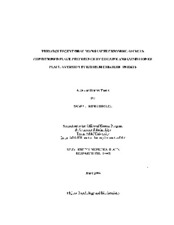| dc.creator | Lee, Samuel Ming Hin | |
| dc.date.accessioned | 2013-02-22T20:40:21Z | |
| dc.date.available | 2013-02-22T20:40:21Z | |
| dc.date.created | 2004 | |
| dc.date.issued | 2013-02-22 | |
| dc.identifier.uri | https://hdl.handle.net/1969.1/ETD-TAMU-2004-Fellows-Thesis-L45 | |
| dc.description | Due to the character of the original source materials and the nature of batch digitization, quality control issues may be present in this document. Please report any quality issues you encounter to digital@library.tamu.edu, referencing the URI of the item. | en |
| dc.description | Includes bibliographical references (leaves 25-27). | en |
| dc.description.abstract | Manganese neurotoxicity compromises basal ganglia functions that could affect the limbic system and drug sensitivity. Male rats were orally exposed to manganese chloride (0, 100, 200 mg/kg/day Mn) for 15 days starting at postnatal day (PND) 28. In Experiment 1, conditioned place preference (CPP) was conducted in a two-compartment apparatus in which cocaine was paired with the least-preferred compartment as determined by a pretest. Animals received 0, 2.5, or 5 mg/kg cocaine HCl (i.p.) for 4 days and, alternatively, vehicle-only for 4 days. Animals exposed to 0 mg/kg/day Mn showed an increased place preference for 2.5 mg/kg cocaine and a reduced place preference for 5 mg/kg cocaine. In contrast, animals exposed to 100 mg/kg/day Mn showed an increased place preference for both 2.5 and 5 mg/kg cocaine, and animals exposed to 200 mg/kg/day Mn showed an increased place preference for 5 mg/kg cocaine only. To determine the possible effects of alterations of learning mechanisms by manganese, a conditioned place aversion (CPA) procedure was employed for Experiment 2. Animals received 40 mg/kg lithium chloride (i.p.) for 4 days, and alternatively, vehicle-only for 4 days. Animals exposed to 100 mg/kg/day Mn and 200 mg/kg/day Mn showed an increased place aversion for 40 mg/kg LiCl when compared to animals exposed to 0 mg/kg/day Mn. However, the increase was not statistically significant. These findings are discussed within a framework of possible manganese-induced disturbance of neurochemical function relating to drug reward and learning. | en |
| dc.format.medium | electronic | en |
| dc.format.mimetype | application/pdf | |
| dc.language.iso | en_US | |
| dc.publisher | Texas A&M University | |
| dc.rights | This thesis was part of a retrospective digitization project authorized by the Texas A&M University Libraries in 2008. Copyright remains vested with the author(s). It is the user's responsibility to secure permission from the copyright holder(s) for re-use of the work beyond the provision of Fair Use. | en |
| dc.subject | psychology and biochemistry. | en |
| dc.subject | Major psychology and biochemistry. | en |
| dc.title | Periadolescent oral manganese exposure affects conditioned place preference by cocaine and conditioned place aversion by lithium chloride in rats | en |
| thesis.degree.department | psychology and biochemistry | en |
| thesis.degree.discipline | psychology and biochemistry | en |
| thesis.degree.name | Fellows Thesis | en |
| thesis.degree.level | Undergraduate | en |
| dc.type.genre | thesis | en |
| dc.type.material | text | en |
| dc.format.digitalOrigin | reformatted digital | en |


